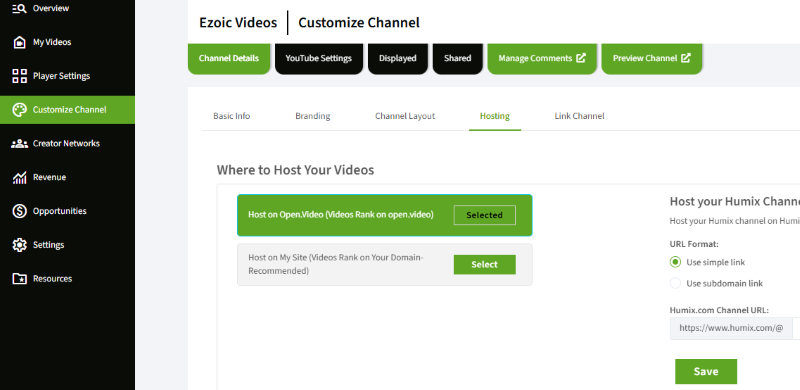Humix (Open.Video) Channel Hosting Showed on Two Domains — How Ezoic Fixed It
Introduction
I’ve tried video monetization with YouTube and Facebook in the past. As Ezoic promoted, their Humix—now rebranded as Open.Video—can out-earn those platforms, especially when you can promote and embed your videos on your own website with ads. In my experience, that claim is true.
However, I ran into an integration quirk with my Humix channel’s hosting configuration. With a quick assist from Ezoic support, it’s now resolved—and I’m sharing the details here in case you see the same thing.
The Setup (and What Went Wrong)
Ezoic gives you two hosting options for your Humix/Open.Video channel:
- Host on Open.Video (Humix’s own domain), or
- Host under your own domain (often auto-provisioned when your site is integrated via Ezoic CDN).
My configuration: I explicitly chose Open.Video hosting.
Despite that choice, my channel remained available at both URLs:
- Open.Video channel:
https://open.video/@your-channel/ - Domain channel:
https://www.example.com/openvideo/
This effectively created two instances of the same channel—identical videos accessible via two different domains.
Why this is a problem
- Duplicate content across two domains
- No canonical tag indicating the primary source
- Potential to split relevance signals and dilute link equity (bad for SEO)
What I expected: Selecting Open.Video should make the domain-hosted version unavailable (or at least 301-redirect to the Open.Video URL).
The Hosting Screen (for context)

My Support Ticket (Summary)
I contacted Ezoic support outlining:
- The chosen hosting option (Open.Video)
- The duplicate availability on both URLs
- The SEO concern (no canonical + duplicate content)
- My desired outcome: keep Open.Video and disable the domain version (or redirect it)
Ezoic’s Response & the Fix
Ezoic confirmed they pushed a fix on their end. After that change:
- Visiting
https://www.example.com/openvideo/now redirects users to the Open.Video channel URL you’ve selected in settings. - They advised clearing caches and retesting (browser cache, site cache, and any CDN layer).
Key point: I didn’t have to change anything on my site. The solution was platform-side.
Note: I understand the fix is platform-wide, but if you still see the issue on your site, open a ticket with Ezoic support so they can check your configuration.
How to Verify the Fix (5 quick checks)
- Clear caches: purge site/CDN caches and hard-refresh your browser.
- Open both URLs:
- Your domain channel path (e.g.,
/openvideo/) - Your Open.Video channel URL
- Your domain channel path (e.g.,
- Watch the behavior: your domain URL should 301 redirect to the Open.Video URL.
- Inspect in DevTools: confirm a 301/302 response and the
Locationheader pointing to Open.Video. - Check search results: over time, search engines should consolidate signals to the Open.Video URL.
Why This Especially Affects CDN-Integrated Sites
If your site is integrated via Ezoic CDN, Ezoic can automatically set up the domain-hosted channel path for you. That convenience can cause confusion when you switch hosting preference to Open.Video—if the domain path remains reachable without a redirect, you essentially have two live versions.
The fix ensures that your selection in the Humix (Open.Video) settings truly governs the live entry point.
Alternatives & Workarounds (If You Still See Duplication)
- Contact Ezoic Support: Reference your settings and URLs; ask them to enforce the redirect from the domain to Open.Video.
- Switch to JavaScript Integration: In JS mode, Ezoic doesn’t automatically control a channel path on your domain; anything that appears there would be something you deployed intentionally.
- Manual Redirect (last resort): If you must, create a server-level 301 from your domain’s channel path to your Open.Video URL. Ideally, platform behavior should already handle this.
SEO Notes & Best Practices
- Prefer a single canonical entry point for the channel (Open.Video or your domain), not both.
- Embedding videos on your site is fine; embeddings won’t create duplicate “channel” pages as long as your channel itself has one authoritative URL.
- When a platform provides hosting toggles, periodically re-check live URLs after changes and confirm that legacy paths redirect.
- Monitor Google Search Console for any duplicate/canonicalization reports and validate fixes.
What I Think of Humix/Open.Video After This
- Revenue: For sites that can promote their own videos, Humix/Open.Video has been stronger than my tests on YouTube and Facebook.
- Flexibility: I like having the Open.Video hub and the ability to embed across my site.
- Support: The response time was quick (resolved within a day), and the fix required no code changes on my end.
No system is perfect, but quick fixes like this build trust. If you’re serious about video monetization and already run a content site, Humix/Open.Video is worth testing.
Key Takeaways
- Selecting Open.Video hosting should make your domain channel URL redirect to Open.Video.
- If you see both URLs serving live content, that’s duplicate content—report it.
- Clear caches and verify redirect behavior after any hosting change.
- Consider JavaScript integration if you want Ezoic to have zero auto-provisioning on your domain.
- Ezoic support can fix platform-side quirks quickly—don’t hesitate to contact them.
Conclusion
My channel now behaves exactly as configured: the domain path redirects to Open.Video, keeping a single, clean canonical entry point. That’s better for SEO and avoids splitting relevance signals. If you hit the same snag, start with cache clears and a support ticket—odds are it’s a quick resolution.
Comments
Insight is best when shared. Found it useful or confused by something? Leave a comment — your thoughts might help others and keep the discussion growing!